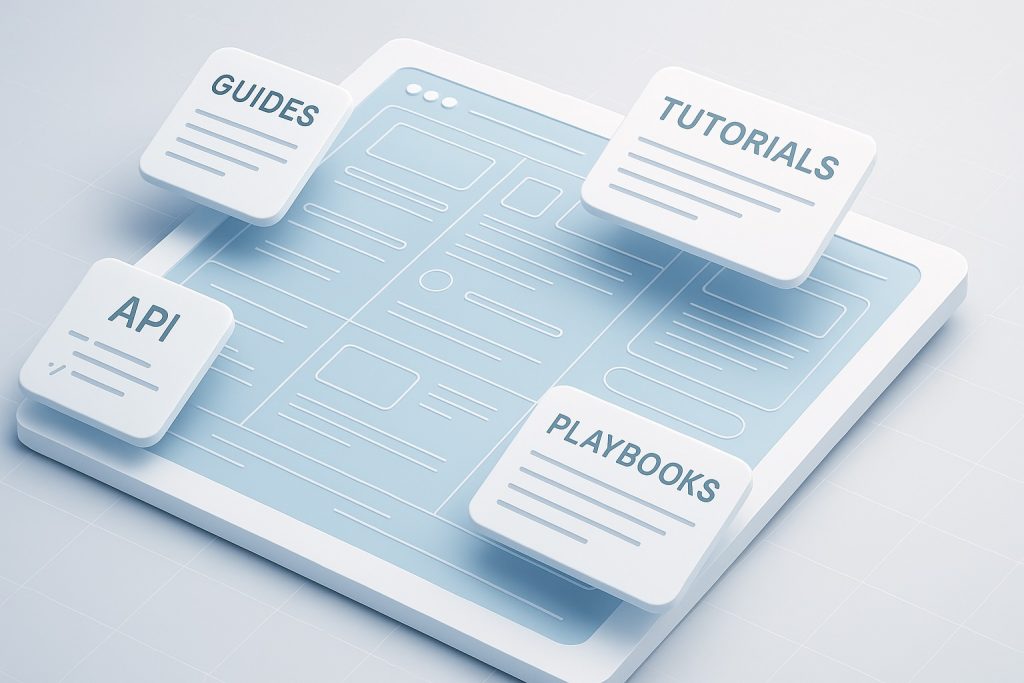For a SaaS team wearing multiple hats, it’s easy to overlook your product documentation as a growth lever. Yet configuration, customization, integration and testing aren’t just technical steps. They’re part of your marketing funnel. Prospective customers in trial or evaluation mode often dive into your help docs to see how your product works and whether they can achieve their goals. If they find clear answers and guidance, they’re far more likely to convert into paying customers. On the other hand, confusing or sparse documentation can stop a deal in its tracks. Many SaaS companies treat documentation as an afterthought. A box to check off once the “real” work is done. That’s a shame, because the potential impact of great docs is significant. In fact, quality documentation can be the secret sauce that turns curious trial users into satisfied customers.
Documentation: A Critical Part of the SaaS Funnel
In B2B SaaS, a product’s help center and knowledge base often act as a second (or even primary) website for prospects. Consider developer-focused products: potential buyers frequently head straight to the API or developer docs right after visiting the marketing page. These technical users will often judge the product by its documentation, treating it as the first port of call after the landing page. If your docs clearly show what’s possible and how to achieve it, you instantly build trust. For example, Twilio prominently features “Documentation” as the very first item in its main navigation, underscoring how vital docs are to its product experience. Documentation isn’t just a post-sale support asset; it’s deeply intertwined with pre-sales and conversion. One SaaS business even found that 12% of all its trial sign-ups originated from just three support pages on its site. In other words, prospects were discovering the product via help articles and then starting a trial, all without a traditional marketing touch. This “side door” into the product is powerful: your documentation can draw in organic traffic, answer pre-purchase questions and funnel motivated users toward conversion.
Great documentation also supports the middle and bottom of your funnel by enabling self-service evaluations. Trials and demos succeed when prospects can easily configure and integrate your solution into their workflow. Comprehensive setup guides, integration how-tos and FAQs reduce friction during this critical phase. Remember that modern buyers have little patience for confusion – 80% of customers have abandoned a software service because they didn’t know how to use it. They won’t necessarily wait on a sales engineer or support ticket for answers. Most, about 73%, prefer to find help on their own. If your documentation empowers them to solve issues and understand the product’s value without outside assistance, you remove major barriers to conversion. Conversely, if a user in trial hits a roadblock (say, an integration error or a tricky feature) and your docs don’t illuminate the solution, they may give up and move on to a competitor. By treating documentation as part of the funnel, you ensure that prospective customers stay on the path to success instead of churning out in frustration.
How Great Help Docs Close the Deal
Great help docs can be the quiet closer that nudges a wavering prospect into a confident buyer. They do this in several ways:
- Building Confidence and Trust: When a potential customer finds well-organized, up-to-date documentation, it signals that your company is invested in customer success. It reassures them that they won’t be left stranded after purchasing. Detailed guides and examples demonstrate the breadth of your product’s capabilities and show that you’ve anticipated their questions. This can make your product feel “safer” to adopt. As one SaaS revenue leader put it, one great piece of product documentation can satisfy an almost indefinite number of customers, including customers still in the evaluation phase.
- Highlighting What’s Possible: Documentation should not be limited to basic how-tos; it’s also an opportunity to showcase use cases, integrations and advanced features that differentiate your product. Don’t hide developer documentation on a separate island – if APIs or customization options exist, make sure your main docs or knowledge base clearly point to them (or integrate them altogether). Prospects should easily discover what they can achieve with your product. For instance, if you offer an API, including code examples and integration guides in your help center (or prominently linking to your developer portal) can be the deciding factor for a technical buyer. Developer audiences especially will seek this info early, and if they don’t find it, they might assume it doesn’t exist. On the flip side, companies that treat developer docs as a core part of the product experience tend to win developer mindshare. Stripe is a famous example. Its documentation is often praised as the gold standard and even cited by influencers as a reason the product feels welcoming. The key is that anyone evaluating your SaaS should quickly grasp what’s possible and how to implement it, straight from your docs.
- Reducing Perceived Implementation Risk: Adopting a new SaaS tool can feel risky to a business. Will we be able to get this set up and working for our needs? Great documentation reduces that fear by spelling out configurations and offering step-by-step guidance. When your help center includes clear setup tutorials, troubleshooting sections and best practices, it helps prospects visualize a successful implementation. They’re not just taking your sales pitch on faith, they can literally see the path to success documented. This clarity can shorten the sales cycle because fewer technical objections arise. In contrast, if your documentation is sparse, a prospect might delay purchase until they can “talk to an engineer” or might choose a competitor with more self-explanatory materials.
- Scalable Customer Success: From a conversion standpoint, documentation is like having a 24/7 customer success team member who can handle infinite volume. Every how-to article or troubleshooting guide in your knowledge base can serve thousands of users at once at virtually no cost. That scalability not only helps existing users but also demonstrates to prospective users that they’ll be supported post-purchase. Essentially, your docs are an extension of your sales team, handling objections and questions automatically. As the team at ChartMogul notes, the more of your product’s functionality covered by good documentation, the more scalable (and efficient) your business becomes. Prospects notice this! Especially if they’re comparing solutions. The SaaS product that makes it easiest to find answers will have an edge in winning the deal.
In short, great documentation closes deals by answering the tough questions before they become deal-breakers. It turns the evaluation process into a frictionless experience. This is particularly valuable for lean SaaS teams that might not have a full-fledged sales engineering crew or live onboarding for every trial. Your docs become the self-serve salesperson that convinces users “you can do this!”
Key Elements of Conversion-Focused Documentation
If documentation is so crucial to conversion, what does great documentation actually look like? There are a few core elements that help your help docs perform as a conversion tool:
- Easy Navigation: A great documentation site should be effortless to navigate. Users evaluate your docs while evaluating your product, so any frustration here can color their impression. Make sure your help center is logically structured with clear categories and an intuitive hierarchy. For example, Airtable’s knowledge base divides content into obvious categories like Getting Started, Troubleshooting and Billing. It then layers sub-categories underneath for more specific topics. Logical structure and categorization ensure that users can quickly drill down to the topic they need. Provide a great search experience as well – often an experienced user will go straight to the search bar to find a solution. Surfacing relevant results fast is key. In one case study, Snyk revamped its docs to make the navigation more welcoming for newcomers and made the search bar prominent for power users to quickly find answers. The payoff is a documentation UX that serves both new and advanced users, keeping both on track. In short, eliminate any friction in finding information. If searching or browsing your docs is arduous, prospects will give up, possibly abandoning the signup or failing to get value from the trial.
- Contextual guidance belongs inside the product: Every unexplained setting or workflow is a missed opportunity. Use subtle but effective tools like question mark icons next to fields, “Learn more” links under settings panels, or embedded help modals that open relevant articles without breaking flow.
- Make your documentation discoverable at the moment of need: Link directly from interface elements to relevant help docs, tutorials, or playbooks. Treat the UI as part of your help system, not separate from it.
- Use contextual linking within docs, too: Add “Next Steps” prompts, breadcrumbs, and in-line links to related articles. A user reading about setting up a webhook should see links to API key setup and payload testing without needing to search manually.
- Clarity and Completeness: While marketing materials might gloss over details, your documentation should embrace them. Complete, straightforward documentation gives prospects the full picture of how to use your product. It’s important that even core docs (like user guides or knowledge base articles) aren’t written in a vacuum that ignores technical possibilities. If there are developer features, mention them or link to their docs; if there are edge cases or common issues, address them openly. Comprehensive docs prevent nasty surprises later. At the same time, clarity is paramount: use plain language, step-by-step instructions, and visual aids where helpful. Remember that prospects are likely skimming and looking for specific answers. Make those answers easy to spot with clear headings, screenshots, or call-out tips. A best practice is to provide context up front in any article about what the reader will find there, so they can tell at a glance if they’re on the right page. If a feature or term might be unfamiliar, define it (even a simple tooltip or glossary entry can help). This level of clarity shows respect for the reader’s time and increases their likelihood of success with your product.
- Unified (or Well-Connected) Documentation: Ensure that your documentation presents a cohesive story. If you have separate portals for different audiences (e.g. a user guide and a developer API reference), bridge them clearly. A user evaluating your product may need both business-level how-tos and technical integration info to make a decision. If those live on different domains or sections, provide obvious links between them. Better yet, consider a unified documentation portal or at least a consistent navigation across all docs. The goal is that a user shouldn’t have to hunt around or Google separately for “API docs” It should be readily accessible from your main help hub. By aligning your “front door” website content and your “side door” docs content, you create a seamless evaluation experience. All documentation, whether for end-users or developers, should consistently convey your product’s value and possibilities. And importantly, keep it public and indexed (avoid putting key docs behind logins). Public, search-friendly docs allow prospects to find answers on their own and even discover your product via search. Hiding docs will only hide your value proposition. Treat every help article as a potential landing page for someone considering your solution.
Conclusion
In the drive to win more customers, great documentation is one of the most cost-effective and impactful tools at your disposal. It directly influences conversions by empowering your prospects to succeed. When your help docs provide a smooth navigation experience, context-rich guidance and clear instructions, you make it easy for potential customers to say “yes” to your SaaS. You’re not just selling a product. You’re selling the ability to get value from that product with minimal friction. In effect, your documentation serves as a quiet marketing and sales agent, showcasing your product’s strengths and guiding users to activation. For resource-strapped SaaS teams (especially those not ready to hire a full-time CMO), doubling down on documentation is a smart move. It scales your expertise, builds trust and helps close deals without expensive campaigns. So take a fresh look at your help center with conversion in mind. By treating documentation as an integral part of the funnel rather than an afterthought, you’ll not only convert more trial users. You’ll also set them up for long-term success with your product. And successful customers, in turn, become happy customers who stick around. It all starts with great documentation.
Sources and Further Reading:
- Natalie Luneva, How to Turn SaaS Product Documentation into a Growth Engine, ProductLed Blog, May 8, 2025
- Archbee Blog, SaaS Product Documentation: A Guide to a Company’s Secret Sauce, March 18, 2024
- Ed Shelley, Documentation: The Under-Appreciated Hero of SaaS, ChartMogul Blog, 2017.
- Sam Richard, Your Developer Documentation Is a Conversion Tool, OpenView Partners Blog, Mar 3, 2021.
- Tom Johnson, Building Navigation for Your Documentation Site: 5 Best Practices, I’d Rather Be Writing, 2021.





